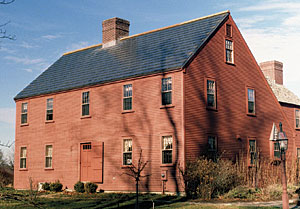
You’ve swapped your incandescent lightbulbs for compact fluorescents, turned down your water heater, and set up your programmable thermostat. These are all good moves toward saving energy in your home, but what else can you do? Builders, architects, and building scientists know lots of tricks for lightening the energy load on our homes, some of them expensive and complicated, but many more simply a matter of taking a second look at what’s already in place. If you’re ready to put a few more check marks on that energy-saving scorecard, here are 25 strategies that can take you to the next level.
1. Get some help from the sun
The sun can help to warm a house in winter, especially when the south side of the house is unshaded from about 9 a.m. until 3 p.m. In northern climates, keeping trees far enough from the south side of the house so that they don’t cast a shadow allows more light—and heat—inside. Deciduous trees can interfere with solar gain even when their leaves are gone. To improve solar gain, it may be necessary to trim trees or even remove them. If the house has photovoltaic panels, keeping shade off south-facing roofs is essential. Removing trees close to the house also reduces the risk of trapped moisture, mold, and decay. Don’t, however, remove shade trees on east- and west-facing sides of the house; this can cause overheating in summer.
2. Control indoor humidity
Ideally, the relative humidity in your house should be maintained somewhere between 30% and 60%. Low humidity can cause eye, nose, and throat irritation in some sensitive individuals. High humidity can encourage the growth of fungi and dust mites, and it makes occupants uncomfortable. Very high and very low humidity are also tough on wood floors and furniture. When outdoor air is warm and humid, an air conditioner or a dehumidifier helps. During the winter, high indoor-humidity levels usually can be addressed by increasing the ventilation rate with a bath exhaust fan. If your house has low indoor-humidity levels during the winter, sealing leaks in your house’s thermal envelope can help.
3. Seek leaks
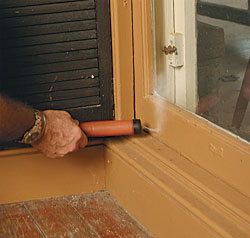
Drafty houses are uncomfortable. Sealing air leaks around only windows and doors may not make a huge impact on overall airtightness, but it will make a noticeable difference in how comfortable your house is. A smoke stick (which emits a noncombustible chemical smoke) or an incense stick is a handy tool for finding leaks. Hold it at the edges of doors and windows. Air leaks will be revealed by the smoke as it moves in the air currents. Leaks between the window sashes and the frames should be sealed with weatherstripping. To seal leaks between the window frame and the rough opening, carefully remove the window casing, and seal cracks with canned foam or caulk. Once the leaks are sealed, reinstall the casing.
4. Switch to a whole-house fan
A fan uses less electricity than central air-conditioning, so using a wholehouse fan to pull cool air into the house at night through open windows can make economic sense. Such a fan is usually installed in the attic floor. In the morning, close the windows, and draw the shades or blinds. The house should stay relatively cool all day long. When outside air cools in the evening, open the windows, and turn on the fan to pull in cooler air. Be sure to open enough windows so that the fan doesn’t pull air from a crawlspace or garage. In humid climates, however, outdoor air must be less humid than indoor air for your home to benefit from a whole-house fan.
5. Add insulation to empty walls
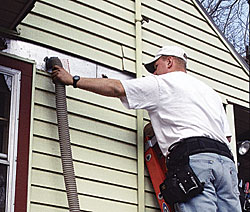
An insulation contractor can insulate empty wall cavities by drilling holes between the studs—either from the inside or the outside, depending on which surface will be easiest to patch— and blowing in new insulation. The most common type of blown-in insulation is dense-packed cellulose, but it’s also possible to use blown-in fiberglass. Some contractors have the equipment and skill to install a special type of slow-rise polyurethane foam to fill closed stud cavities. Foam insulation is inherently more airtight than blown fiberglass or cellulose, but it’s also more expensive.
6. Take action with a home-energy audit
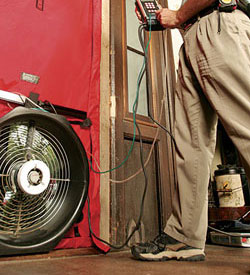
Home-energy audits can be conducted by inspectors who specialize in single-family homes or by technicians who work with local weatherization programs or utilities. A good energy audit assesses air leaks, indoor-air quality, insulation, combustion safety, and the durability of building components. Most energy audits include the use of an infrared camera—a tool that can identify insulation defects or air leaks—and a blower door, which measures how leaky your home is and helps to identify points of infiltration. A home-energy audit won’t save any energy itself, but carrying out the recommended improvements will.
7. Seal ducts for savings
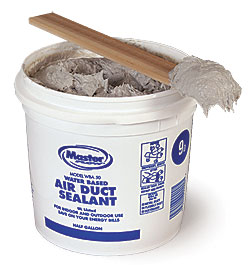
Leaky ducts on forced-air heating and air-conditioning systems are a common problem, contributing to both lower indoor-air quality and lower energy efficiency. They also make mold and decay more likely. The seams of supply and return ducts should be sealed with mastic or an appropriate HVAC tape. Don’t use hardware-store “duct tape,” which dries out quickly and fails. If your home has ducts that run through an unconditioned space (such as an unheated attic or crawlspace), the ducts should be insulated.
8. Use an occupancy sensor to turn off computer peripherals
A great deal of equipment uses energy even when it’s turned off. A good way to save some of this so-called “phantom” electrical load is to connect an occupancy sensor to an outlet strip that powers printers, monitors, and other computer peripherals. While the computer itself remains on, the sensor turns off peripheral equipment after your office is unoccupied for a set period of time.
9. Keep your cool with efficient lights and appliances

The right appliances and lighting fixtures not only save electricity but also can reduce your home’s cooling costs by lowering internal heat gain. Incandescent lightbulbs, for example, turn 90% of the energy they consume into heat; fluorescent or LED fixtures produce less heat and more light. Similarly, energy-efficient appliances use less power and therefore give off less heat when they’re operating, lowering your cooling costs.
10. Move the air with ceiling fans
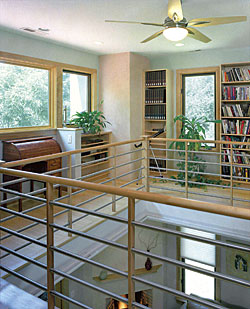
Ceiling fans can be a great way to cut down on air-conditioning costs. When used properly, ceiling fans save energy and make us feel more comfortable by supplying moving air, which cools the skin through evaporation. If you’re aiming to save energy, it makes little sense to use a ceiling fan unless your air conditioner is off. It’s also important to turn off a fan when occupants leave the room. Leaving on ceiling fans in unoccupied rooms wastes energy and even adds a bit of heat from the motor to the room.
11. Rethink your approach to air-conditioning
When only one or two rooms need air-conditioning, running a couple of window-mounted units is less expensive than running a ducted central system. If room air conditioners are chosen over a central air-conditioning system, choose models that meet or exceed Energy Star standards for efficiency; they will cost less to operate than unrated ones. Qualifying models are at least 15% more efficient than required by minimum federal standards. If you are replacing a central air conditioner, look for a unit with a high SEER (seasonal energy-efficiency ratio) rating, and make sure the equipment is not oversize. In a hot, humid climate, choose a unit that has a sensible heat ratio (SHR) that is no more than 0.70.
12. Balance your home’s air pressure
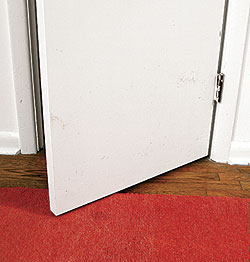
Pressure imbalances inside your house can lead to uneven heating and moisture problems in exterior walls. To identify room-to-room pressure imbalances, a technician turns on the air handler, closes all interior doors to the room, and measures pressure differences between rooms with a two-station, handheld manometer. (A manometer is a device that measures the pressure of liquids or gases.) The acceptable pressure difference from room to room is 3 pascals. Correcting imbalances in existing homes typically involves either trimming doors by at least 11⁄2 in. or installing offset transfer grilles just above bedroom doors. It’s also possible to install a jumper duct that connects a grille in the room with a grille in a common hallway. The best solution, however, is to install a return-air duct from every bedroom back to the furnace or air handler.
13. Use outdoor air to heat and cool
Effective natural ventilation can reduce the need for air-conditioning and can even aid in heating under some circumstances.
A house designed for cross ventilation will get the most out of natural cooling, but you can encourage air movement in any home. When the air outside is pleasant, open a window on the downwind side to allow hot indoor air to be pulled from the house, and open a window on the upwind side to allow cooler outdoor air in. It’s also possible to introduce fresh air with a mechanical ventilation system, such as a fan.
In a heating climate, make sure the supply air for your ventilation system is drawn from the warm, sunny side of the house. In a cooling climate, draw supply air from a cool, shady area. In all climates, ventilation air should be drawn from areas that aren’t susceptible to low air quality. Avoid placing supply vents near dryer vents or parking lots.
14. Consider an evaporative cooler
An evaporative cooler, also called a swamp cooler, uses significantly less energy to operate than an air conditioner. Evaporative coolers work by drawing incoming air through dampened pads, cooling the air while adding moisture. Direct evaporative coolers are well suited to dry climates but may cause interior moisture problems where humidity is high. An indirect evaporative cooler cools air that is then sent through an air-to-air heat exchanger; this trick can cool recirculated indoor air without raising its humidity. Evaporative coolers have some downsides, though: They use a lot of water, and the equipment needs regular maintenance.
15. Install an effective bathroom fan
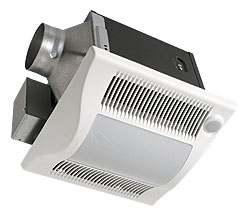
Every bathroom needs an exhaust fan to remove damaging moisture, and a quiet fan is more likely to be used than a noisy one. The lower the sone rating, the quieter the fan. Several manufacturers offer fans with sone ratings of less than 1; they are essentially inaudible when running. A fan with an Energy Star rating will use less energy than an unrated fan, and a timer or an automatic control will improve performance even more.
Long duct runs with lots of elbows lower fan performance; keeping ducts as short and as straight as possible makes it easier for an exhaust fan to move all the air that it’s rated to handle. If the duct run is well designed, you may be able to use a smaller fan, saving energy and reducing noise.
16. Minimize skylights
Although many homeowners appreciate the daylight that skylights provide, they may not realize that skylights always carry an energy penalty. Skylights are difficult to shade. In summer, when cooling loads are the highest, skylights are often exposed to intense sunlight, regardless of the direction the roof faces. All that solar gain can make it a challenge to keep the indoors cool. Although interior shades can help to reduce glare, they aren’t particularly effective at limiting heat gain. If you have an older skylight, you might want to upgrade to a new skylight equipped with low-solar-gain double or triple glazing. Most skylights also allow a lot of indoor heat to escape during the winter.
17. Find and fix any plumbing leaks
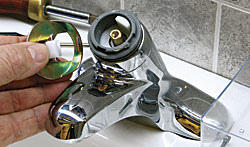
Plumbing leaks waste water and may lead to mold and serious structural decay. If the leak is in a hot-water line, it also wastes energy. Research shows that an average single-family home wastes nearly 14% of its indoor water because of leaks. Worn-out faucet washers and worn-out toilet flapper valves are two of the most common sources of leaks; both are easy to fix.
18. Pair your boiler with an indirect water heater
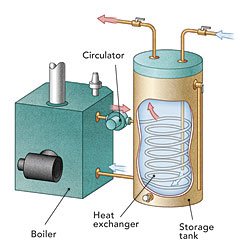
Indirect systems are more efficient than most conventional water heaters. In an indirect system, a hotwater loop from the boiler heats water in a separate storage tank via a heat exchanger. The system is efficient, and indirect equipment enjoys a longer service life and lower operating costs than standard water heaters. The boiler runs only when water in the storage tank is drawn down enough to activate the aquastat. Avoid tankless boiler/water-heater systems, which use a heat exchanger inside the boiler to provide hot water. They are inefficient, especially in the summer, because the boiler fires every time hot water is called for.
19. Shade south-facing windows
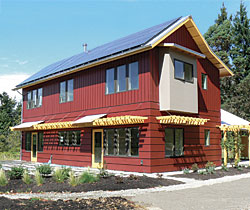
The sun can easily overwhelm a house in summer. Exterior louvers, trellises, or awnings help to shade your windows, keeping the house cool. Louvers are preferable to awnings because they do a better job of shading windows when the sun is at a low angle or from the side; they also provide a partial view through the window. Trellises also can be used to shade windows from direct sunlight. Using one of these features may allow your house to have a smaller airconditioning system.
20. Install solar-control film to minimize window heat gain
If your existing windows have single glazing or older glazing, they may be contributing to summer overheating. One solution is to replace some of your windows with newer windows equipped with low-solar-gain glazing. However, replacing windows is expensive and rarely cost-effective from an energy perspective. A less expensive solution is to install an interior solar-control film on your existing windows. Unlike tinted films of the past, newer solar-control films have low-e coatings that reduce solar-heat gain without noticeably affecting the view. When placed next to an uncoated window, however, a coated window will appear slightly gray.
21. Use storm windows
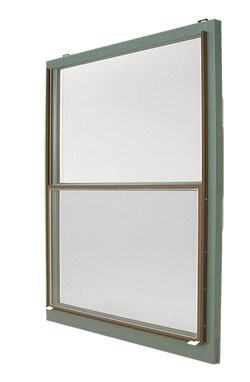
A storm window can double the insulation value of a single-glazed window and can help to reduce air leakage. When ordering storm windows, be sure to specify glazing with a hard-coat low-e coating. Research has shown that storm windows significantly improve the performance of single-pane windows. When installed on the exterior, storm windows shield the existing sashes from water and sunlight degradation. Also, storm windows—particularly airtight ones—can substantially reduce noise from outside.
22. Install low-flow showerheads
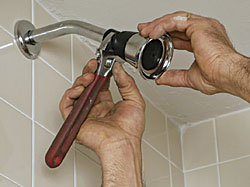
Older showerheads often use lots of water. Federal law requires that new showerheads use no more than 2.5 gallons per minute (gpm), half the flow rate for many older models. Today, excellent performance is available with models that use as little as 1.5 gpm. That’s a lot of hot water saved. Consider mounting the showerhead on a sliding arm; bringing the showerhead closer makes the shower more satisfying at lower flow rates.
23. Use a drain-water heat-recovery system to heat water
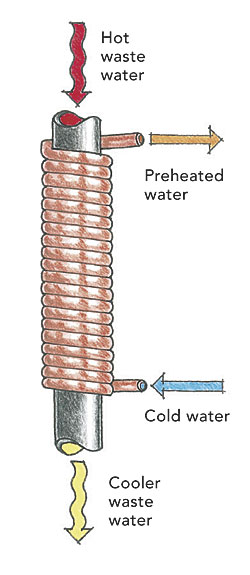
A heat-recovery system captures heat from drain water that would otherwise be lost. The simplest systems consist of a section of vertical copper drain line wrapped with copper tubing and no storage tanks. These systems recover heat only when hot water is being used at the same time that warm water is flowing through the drainpipe (when someone takes a shower, for example). These systems have no moving parts to fail and are quite cost-effective, as long as family members prefer showers to baths.
24. Light the way with Energy Star
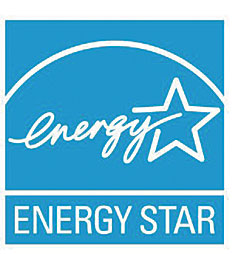
If you want energy-efficient lighting products, choose lightbulbs and light fixtures with the Energy Star label. Lighting accounts for 20% of the power bill in an average U.S. home, so the potential for savings is high. Compact-fluorescent lamps, LEDs, and Energy Star fixtures are much more efficient than incandescent bulbs and fixtures. Lighting meeting Energy Star standards shows good color rendition, low noise, and minimal flickering on startup. Energy Star-rated light fixtures generate about 75% less heat than standard incandescent lamps, and they come with a two-year warranty instead of the usual one-year warranty.
25. That goes for appliances, too
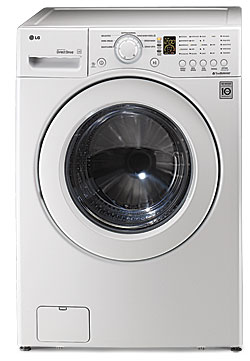
Dishwashers with an Energy Star rating are at least 25% more efficient than dishwashers meeting minimum federal standards. New Energy Star refrigerators exceed minimum federal efficiency standards by 20%. Look for a washer with an Energy Star label or a high rating from the Consortium for Energy Efficiency (CEE). (The front-loading model shown at left, an LG WM21440CW, has a Tier 3 rating, the CEE’s highest.) A high-quality washing machine uses less water, is easier on clothes, and uses less energy than a low-quality model. Horizontal-axis (front-loading) washers are more expensive than top loaders but typically use less energy and water. However, some top-loading models meet Energy Star requirements.


























View Comments
Please provide some examples / sources of louvers and shades for south facing windows. I like this idea, especially if they also provide shielding against rain showers.